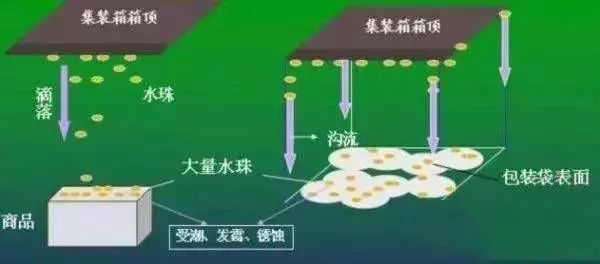 Scan and follow WeChat
Scan and follow WeChat
After professional inspection at the port, the container showed no issues; weather during transit was sunny and dry; cargo was strictly checked for moisture during loading. Why upon arrival are container walls covered in water droplets, packaging soaked, and goods rusted? Who bears responsibility for severe losses?

Causes of Moisture Damage
Container moisture depends on weather conditions, voyage duration, packaging materials, container condition, and cargo sensitivity. Fungus, mold, and mildew damage goods when relative humidity exceeds 55%.
Water sources in containers fall into four categories:
Moisture from the cargo itself
Container condensation ("container rain")
Seawater intrusion
Freshwater intrusion
1. Moisture from Cargo
Dampness or moisture enters with the cargo. Example: 5 tons of furniture may contain 8%-25% humidity (400-1,250 liters of water), depending on wood type and drying processes. This humidity gradually releases into the container air, becoming a major condensation source.
2. Container Condensation
During ocean transit or storage, containers experience temperature fluctuations (0-8°C) and high humidity (up to 98%), causing "sweating." At 30°C, air holds 30.4g/m³ of moisture. When temperature drops to 18°C, vapor condenses into droplets – a 40ft container can generate 1,000g of condensed water ("container rain").
3. Seawater Intrusion
Damage sustained during storms, container defects, deck positioning, or maritime accidents can allow seawater ingress.
4. Freshwater Intrusion
Rain, snow, or burst freshwater pipes on vessels can penetrate containers through roof/side panel damage, door seal gaps, etc. Recent typhoons have intensified this risk.
Insurance Coverage
Freshwater Rain Damage (FWRD): Covers losses from freshwater (ship pipelines, leaks, condensation).
Heating & Sweating Risks: Compensates for damage from sudden temperature changes or poor ventilation causing humidity buildup.
With Particular Average (WPA): Covers seawater damage only – not freshwater losses.
Prevention Measures
Moisture damage is preventable.
Pre-loading: Verify container seals and internal dryness.
Confirm cargo & loading environment are dry.
Enhance waterproof packaging.
Strategically place desiccants inside containers.
Implement end-to-end real-time cargo tracking.
Maintain all shipping documents for claims evidence.
Source: Shipping Gazette